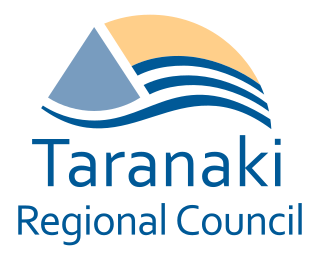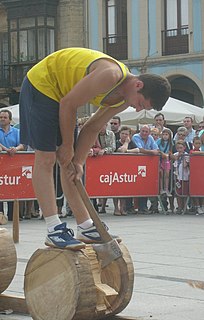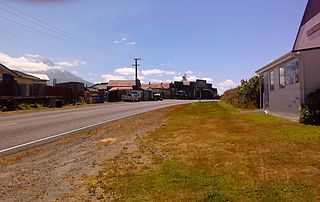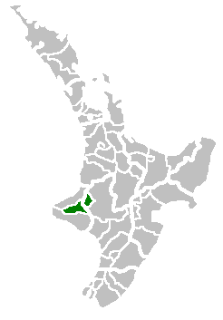
Taranaki is a region in the west of New Zealand's North Island, administered by the Taranaki Regional Council. It is named after its main geographical feature, the stratovolcano of Mount Taranaki.

New Plymouth is the major city of the Taranaki Region on the west coast of the North Island of New Zealand. It is named after the English city of Plymouth from where the first English settlers migrated. The New Plymouth District, which includes New Plymouth City and several smaller towns, is the 10th largest district in New Zealand, and has a population of 74,184 – about two-thirds of the total population of the Taranaki Region and 1.7% of New Zealand's population. This includes New Plymouth City (58,300), Waitara (6,483), Inglewood (3,380), Oakura (1,359), Okato (561) and Urenui (429).
The First Taranaki War was an armed conflict over land ownership and sovereignty that took place between Māori and the New Zealand Government in the Taranaki district of New Zealand's North Island from March 1860 to March 1861.

Mount Taranaki, or Mount Egmont, is an active but quiescent stratovolcano in the Taranaki region on the west coast of New Zealand's North Island. Although the mountain is more commonly referred to as Taranaki, it has two official names under the alternative names policy of the New Zealand Geographic Board. The 2,518 metres (8,261 ft) mountain is one of the most symmetrical volcanic cones in the world. There is a secondary cone, Fanthams Peak, 1,966 metres (6,450 ft), on the south side. Because of its resemblance to Mount Fuji, Taranaki provided the backdrop for the movie The Last Samurai.

David Foster OAM is a world champion woodchopper, and Tasmanian community figure. He has held the World Woodchopping Championship title for 21 consecutive years, and is Australia's most successful athlete and possibly the only athlete in any sport in the world to win over 1000 titles.

Woodchopping, called woodchop for short, is a sport that has been around for hundreds of years in several cultures. In woodchopping competitions, skilled contestants attempt to be the first to cut or saw through a log or other block of wood. It is often held at state fairs and agricultural shows. Participants are often referred to as axemen.
Richard "Dicky" Barrett (1807–1847) was one of the first European traders to be based in New Zealand. He lent his translation skills to help negotiate the first land purchases from Maori in New Plymouth and Wellington and became a key figure in the establishment of the settlement of New Plymouth. He was described by Edward Jerningham Wakefield, son of New Zealand Company founder Edward Gibbon Wakefield, as short, stout and "perfectly round all over" and fond of relating "wild adventures and hairbreadth 'scapes".

Ngaere is a village situated on State Highway 3, 4 kilometres (2.5 mi) south of Stratford, New Zealand. The name "Ngaere" literally means "swamp" in English, and before settlement, the area was covered by a vast and ancient wetland.
David Ernest Walter is a New Zealand politician and journalist. He is the immediate past Chairman of Taranaki Regional Council, past Chairman of Stratford County Council, and the first Mayor of Stratford District Council.
The city of New Plymouth, New Zealand, has a history that includes a lengthy occupation and residence by Maori, the arrival of white traders and settlers in the 19th century and warfare that resulted when the demands of the two cultures clashed.

James Crowe Richmond was a New Zealand politician, engineer, and an early painter in watercolours of the New Zealand landscape.

Cardiff is a settlement in inland Taranaki, in the western North Island of New Zealand. It is located five kilometres southwest of Stratford close to Egmont National Park.

The Lumberjack World Championships are held annually in Hayward, Wisconsin. The event began in 1960 and is held at the Lumberjack Bowl. There are 21 events for both men and women to compete for over $50,000 in prize money. Contestants come from the United States, Canada, Australia, and New Zealand. The events include sawing, chopping, logrolling, and climbing to test the strength and agility of over 100 competitors.

Bell Block is a town in Taranaki, New Zealand. State Highway 3 runs through it. It is 6 km north-east of the centre of New Plymouth and 1 km from the outer edge of New Plymouth at Waiwhakaiho. Waitara is about 9 km to the north-east. New Plymouth Airport is located immediately to the north-east of Bell Block.
The Taranaki Herald was an afternoon daily newspaper, published in New Plymouth, New Zealand. It began publishing as a four-page tabloid on 4 August 1852. Until it ceased publication in 1989, it was the oldest daily newspaper in the country.
William Douglas Cook was the founder of Eastwoodhill Arboretum, now the national arboretum of New Zealand, and one of the founders of Pukeiti, a rhododendron garden, close to New Plymouth. He was a "plantsman with the soul of a poet and the vision of a philosopher".

Henry James Hobbs Okey was a Reform Party Member of Parliament in New Zealand.
Monica Romaine Brewster was a New Zealand arts patron and women's rights advocate. She is best known as the founding benefactor of the Govett-Brewster Art Gallery.
Stirling Hart is a professional lumberjack.





















